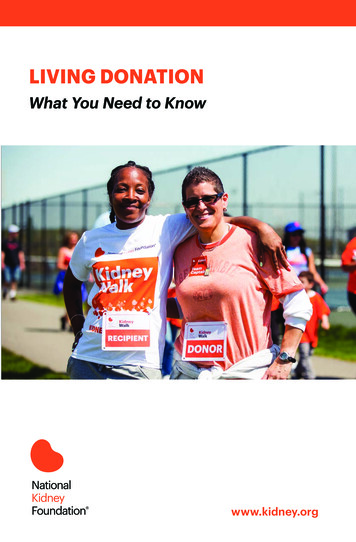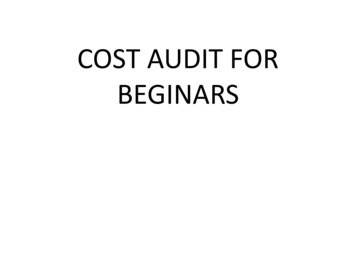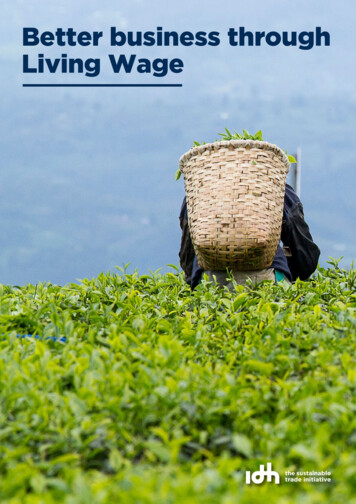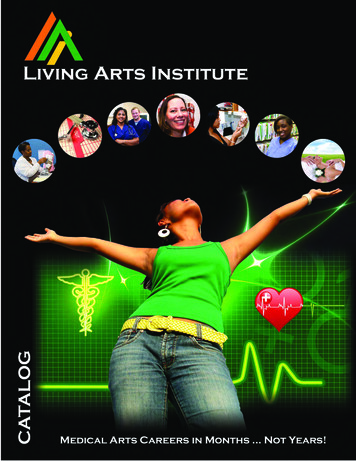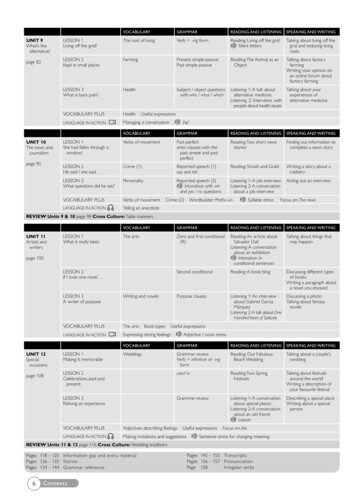
Transcription
THE COST OF LIVINGAND LEVELLING UPWhy the povertypremium mattersfor local economiesUse our interactivemap to see thepoverty premium inyour local area
WHAT IS THE POVERTY PREMIUM?The poverty premium is the extra costs people on low incomes and inpoverty pay for essential products and services. Examples of the povertypremium include:USING PREPAYMENT METERSUSING ‘NON-STANDARD’FOR GAS AND ELECTRICITYBILLING METHODSe.g. paying onreceipt of bill,rather than viadirect debit, andpaying more forinsurance if it ispaid for monthlyinstead of payingthe full amount upfrontPAYING MORETAKING OUTINSURANCEFORINDIVIDUALAPPLIANCESFOR HOME CONTENTS OR CAR INSURANCEBECAUSE OF WHERE YOU LIVECREDIT%USING HIGH INTEREST LOANS& CREDIT CARDS PAYING MORETO ACCESSMONEYCHARGES%e.g.through fee-chargingatms or pre-paid cardfeesRATESL OANMONTH0 0 6. 1 0 0 1 4. 9 02ATM
THE IMPACT OF THE POVERTY PREMIUMON LOCAL ECONOMIESOf the 632 constituencies, Leeds Central( 8.9 million), Manchester Central ( 8.4 million),West Ham ( 8.3 million), Blackley and Broughton( 7.9 million) and Hackney South and Shoreditch( 7.8 million) have the largest total povertypremiums in the UK.As UK households face thesharpest increase in the cost ofliving in a generation, it is moreimportant than ever to keepas much money as possible inpeople’s pockets.Parliamentary seats that the Conservativeswon from Labour at the 2019 election typicallyexperience a higher proportion of peopleincurring the poverty premium than seats thatthe Conservatives previously held (14% vs 11%).This report reveals the economic impact of thepoverty premium at a constituency level acrossBritain. A joint project between Fair By Design andthe University of Bristol, this research highlightsthe opportunity government has to strengthen localeconomies across Britain by taking centralisedaction on the poverty premium.1THE COST OF THE POVERTY PREMIUM TO ATYPICAL PARLIAMENTARY CONSTITUENCY IS4.5 MILLION A YEARTHIS EQUATES TOKey findings reveal:One in eight British households (13%) areestimated to experience at least one type ofpoverty premium.OVER 430 PER YEARFOR A LOW INCOME HOUSEHOLDThe cost of the poverty premium to a typicalparliamentary constituency is 4.5 million a year.This equates to over 430 per year for alow income household – equivalent to nearly10 weeks’ grocery shopping.2The North East of England (14.7%) has the highestproportion of households incurring the povertypremium, followed by the North West (13.4%),Yorkshire and the Humber (13.4%), London (13.1%)and Wales (13.1%).EQUIVALENT TO NEARLY10 WEEKS’ GROCERY SHOPPINGUse our interactive mapto see the poverty premiumin your local area1 The University of Bristol (2022) Mapping the Poverty Premium in overty-premium/2 Average of 44.60 pw for bottom four deciles of income (Living Costs and Food Survey 2020).3
The national cost of the povertypremium is 2.8 billionReturning 4.5 million to local economiesReducing the amount of money low-incomehouseholds spend on essential services not onlyhas direct benefits for families and their budgets butwould return an extra 4.5 million into the averageconstituency’s economy.Benefits to the public purseBenefits would also be felt by the public purse.Ending the poverty premium would reducehouseholds’ reliance on State support and the useof local and national services, such as the use ofpublicly funded food banks, debt advice servicesand the costs associated with servicing debt.Council tax arrears currently stand at 4.4 billion –a problem for both the households who have fallenbehind and the local authorities trying to fundservices.6 Collection practices are also costly –adding on average 278 to the debt of those whofall into arrears, as well as the cost of employingbailiffs and courts to address these.7 Reducing theamount of money low-income households spendon essential services would ensure they are betterable to manage other expenditure and reduce thelikelihood of running into arrears on other bills.INCREASING THE AMOUNT OF MONEYHOUSEHOLDS HAVE IN THEIR POCKETSWOULD HAVE WIDER SOCIAL ANDECONOMIC BENEFITSINCLUDING THRIVING LOCAL BUSINESSES,JOB CREATION AND STRONGER SOCIALLINKS WITHIN COMMUNITIESTaking direct action to eliminatethe poverty premium wouldincrease living standards andstrengthen local economies.This would provide the governmentwith the opportunity to soften theimpact of the cost of living crisisfor those most in need of help andmeet the objectives of some of itslevelling up aspirations, withoutrequiring any additional fundingfrom the Treasury.Low-income households spend more in their localeconomy than other groups.3 Increasing the amountof money these households have in their pocketswould have wider social and economic benefits, inthe form of thriving local businesses, job creationand stronger social links within communities.4A study from Portland, USA estimates that forevery 100 spent in local shops, an additional 58is contributed to the local economy, in comparisonwith an extra 33 for national shops.5The local cost of the povertypremium is 4.5 million34567The University of Bristol (2022) Mapping the Poverty Premium in Britain.Sacks, J (2002) The Money Trail: Measuring your impact on the local economy using LM3. New Economics Foundation.Rybaczewska M & Sparks L (2020) Locally-owned convenience stores and the local economy. Journal of Retailing and Consumer Services, 52.GOV.UK: Collection rates for Council Tax and non-domestic rates in England, 2020 to 2021.Derricourt, R, Lane, J, McDonagh, E and Thorne, M (2019) The Costs of Collection The high price of council tax debt collection. Citizens Advice.4
THE POVERTY PREMIUM IN BRITAIN:MAPPING THE IMPACTImpact of the poverty premium by regionThe geography of the povertypremium in Great Britain.At a regional level, the North East has the highestproportion of households experiencing the povertypremium: the average constituency in the NorthEast has 14.7% of households experiencing thepremium, compared to 11.0% in the South East.In terms of absolute cost, the average constituencycost is highest in London and the North East, at 5 million per constituency. This equates to a totalcost of over 360 million to London householdsper year.BISHOP AUCKLAND110th87,000 most deprivedPEOPLEHOME TO% of householdsexperiencing at leastone componentof the povertypremium, byconstituencyconstituency in the coun0 0 6. 1 00 1 4. 9 0Use our interactive mapto see the poverty premiumin your local area5 480Over 4,000 households rely onelectricity pre-payment metersand many more households usenon-standard arrangements forpaying their energybills (e.g.,Payment on receiptof bill ratherthan direct debit) which takes intotal, over 800,000out of theirhousehold budgets.The premium for livingin a deprivedarea has for insurance totals over1.2 million. If even one quarter of thetotal poverty premiumwas removed,then over 1.3 million would flow backinto the local economy.8 Ministry of Housing, Communities and Local Government, Deprivation in English Constituencies, 2019.Nearly 15% of householdsexperience a povertypremiumcosting them an extra480 ayear for their essential services.try 81.2m
BLACKLEY & BROUGHTONHOMETO NEARLY4th110,000 most deprivedconstituency in the country 9% of householdsexperiencing at leastone componentof the povertypremium, byconstituency0 0 6. 1 00 1 4. 9 09 Ministry of Housing, Communities and Local Government,Deprivation in English Constituencies, 2019.Nearly 20% of householdsexperience a povertypremium.The highest in England and Wales– costing them an extra 497a year for their essential services.PEOPLE 497Over 11,000 households rely onelectricity pre-payment meters, theextra cost of payingfor electricityand gas via prepayment meterstakes over 730,000 a year out ofthe pockets of localpeople.The premium that living in a deprivedarea has on insurance totals nearlyover 2 million. If even one quarter ofthe total poverty premium was removed,then over 1.9 million would flow backinto the local economy.2m% experiencing anypoverty premiumAverage constituencycost of all premiumsTotal cost of all premiums forentire regionNorth East(N 29 constituencies)14.7% 5,025,164 145,729,745North West (N 75)13.4% 4,841,754 363,131,517Yorkshire andThe Humber (N 54)13.4% 4,888,512 263,979,672London (N 73)13.1% 5,040,067 367,924,905Wales (N 40)13.1% 3,745,448 149,817,930West Midlands (N 59)12.8% 4,611,447 272,075,391East Midlands (N 46)12.5% 4,508,086 207,371,966Scotland (N 59)12.2% 4,102,808 242,065,693South West (N 55)11.8% 4,169,628 229,329,523East of England (N 58)11.7% 4,211,719 244,279,723South East (N 84)11.0% 3,971,148 333,576,409Total (N 632)12.6% 4,460,890 2,819,282,473Region6
Impact of the poverty premiumby constituencyConstituencies with the highest exposure to thepoverty premium also score highly on the UKgovernment’s deprivation rankings.ConstituencyIn monetary terms, this equates to approximatelya 1.1 million difference in total poverty premiumcosts between the average newly won seat andseats that the party held at the election ( 5.0 millionvs 3.9 million). The average Labour seat has apoverty premium of 5.5 million.Total cost of allpremiums toconstituency1. Leeds Central 8,837,9962. Manchester Central 8,362,4203. West Ham 8,323,7344. Blackley andBroughton 7,973,0995. Hackney South andShoreditch 7,857,0786. BirminghamLadywood 7,686,3077. Liverpool Walton 7,657,9768. Tottenham 7,639,1249. Camberwell andPeckham 7,553,45310. Barking 7,510,800Marginal seats gained by theConservatives with high levelsof the poverty premium include:Stoke-on-Trent Central(16.6% of households experiencingthe poverty premium)Great Grimsby (16.5%)Kensington (16.3%)Wolverhampton North East (16.1%)Marginal seats held by Labourwith high levels of the povertypremium include:Nottingham North (18.9% ofhouseholds experiencing thepoverty premium)Normanton, Pontefract andCastleford (15.7%)Birmingham Erdington (16.7%)Analysing the data through this lens highlights thesignificance of tackling the poverty premium fornational policy makers.The geography of the poverty premium:political implicationsGovernment intervention to eliminate thepoverty premium would put on average 430 back into the pockets of over 3.5million low income households withoutrequiring any additional funding fromthe Treasury.10 This has the potential tosoften the rise in the cost of living, reducelow income households' reliance on thepublic purse and meet key objectives of thelevelling up agenda.Analysis of the data reveals interesting politicalimplications ahead of the next general election.Many of the seats gained by the Conservatives inthe 2019 election have a higher poverty premiumlevels (median 14%) than seats the Conservativestraditionally held (median 11%).10 Office for National Statistics, Families and households in the UK, 2021.7
TIME FOR ACTIONThe need to reduce or eliminate the povertypremium has never been more urgent.Those who are vulnerable to povertypremiums are increasingly falling intoarrears or drawing on costly credit toget by. The consequences of this willfall on both local and national services.More people will seek debt and otheradvice services, use foodbanks andrely on emergency support such ascrisis loans.The public purse should nothave to pick up the costs ofproviding these serviceswhen poverty premiumsare often created by thecommercial practises ofnational (or international)companies.Use our interactive mapto see the poverty premiumin your local area8
RECOMMENDATIONS10GovernmentGovernment to introduce a social tariff for low-income consumers who arestruggling with energy costs.Government to initiate industry action on ensuring the insurance industrymeets the needs of low-income consumers (see below).10Government to give the Financial Conduct Authority (FCA) a new cross-cutting ‘musthave regard’ to financial inclusion as part of its Regulatory Framework Review to ensureit considers financial inclusion across all of its activities.10RegulatorsThe FCA to investigate how well the insurance market is meeting the needsof low-income consumers.The FCA to introduce a price cap on all forms of credit, e.g., home collectedcredit, pawnbroking and guarantor loans.The FCA to stop the ‘non-standard billing methods’ premium of insurerscharging more to customers who pay monthly for their insurance.Ofgem to stop energy companies charging customers more for not paying by DirectDebit (including prepayment meter customers).The Payment Systems Regulator to ensure inclusive payment methods, such as Requestto Pay, are available at an affordable price to utility providers. 11IndustryEnergy companies to stop charging customers more for using prepaymentmeters. Energy companies should also offer customers on other tariffs moreflexible ways to pay bills such as Request to Pay.The insurance industry to introduce services to better serve low-incomeconsumers. For instance, replicating the success of FloodRe to other areasof insurance where consumers are priced out of the market.1211 t-to-pay12 Flood Re is a joint initiative between the Government and insurers. Its aim is to make the flood cover part of household insurance policies more affordable. www.floodre.co.uk9
This document summarises research from a report,Mapping the Poverty Premium in Britain,produced by the Personal Finance Research Centreat the University of Bristol for Fair By Design in 2022.A full report can be found at:fairbydesign.com/povertypremiumAbout Fair By DesignFair By Design is dedicated to reshaping essential servicessuch as energy, credit and insurance, so that they don’t cost moreif you’re poor – the poverty premium.We collaborate with regulators, government and industry to design outthe poverty premium. Our Venture Fund provides capital/funding to grownew scalable ventures to innovate the market and design out the povertypremium. Ascension manages the Fair By Design Fund.Fair By Design is managed by the Barrow Cadbury Truston behalf of a group of foundations.Charity number: 1115476. Registered in England No: 5836950.
In terms of absolute cost, the average constituency cost is highest in London and the North East, at 5 million per constituency. This equates to a total cost of over 360 million to London households per year. Over 4,000 ely on s e households use or gy bills (e.g., ather ect debit) es in al, over 800,000 out of their s. 0 6. 1 0 0 1 .




